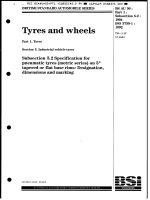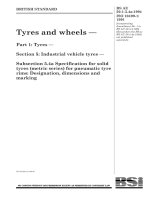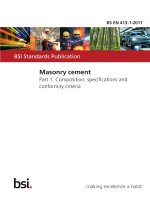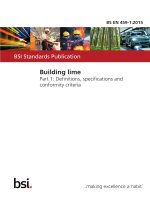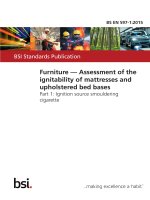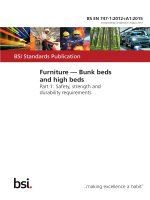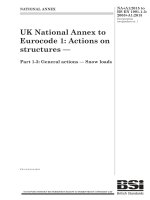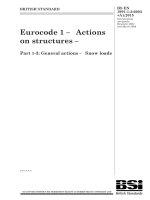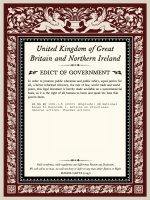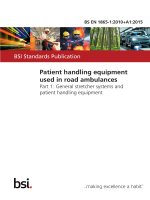Bsi bs en 61338 1 5 2015
Bạn đang xem bản rút gọn của tài liệu. Xem và tải ngay bản đầy đủ của tài liệu tại đây (1.62 MB, 26 trang )
BS EN 61338-1-5:2015
BSI Standards Publication
Waveguide type
dielectric resonators
Part 1-5: General information and test
conditions — Measurement method of
conductivity at interface between conductor
layer and dielectric substrate at microwave
frequency
BRITISH STANDARD
BS EN 61338-1-5:2015
National foreword
This British Standard is the UK implementation of EN 61338-1-5:2015. It is
identical to IEC 61338-1-5:2015. It supersedes DD IEC/PAS 61338-1-5:2010
which is withdrawn.
The UK participation in its preparation was entrusted to Technical
Committee EPL/49, Piezoelectric devices for frequency control and
selection.
A list of organizations represented on this committee can be obtained on
request to its secretary.
This publication does not purport to include all the necessary provisions of
a contract. Users are responsible for its correct application.
© The British Standards Institution 2015.
Published by BSI Standards Limited 2015
ISBN 978 0 580 82905 5
ICS 31.140
Compliance with a British Standard cannot confer immunity from
legal obligations.
This British Standard was published under the authority of the
Standards Policy and Strategy Committee on 30 September 2015.
Amendments/corrigenda issued since publication
Date
Text affected
BS EN 61338-1-5:2015
EUROPEAN STANDARD
EN 61338-1-5
NORME EUROPÉENNE
EUROPÄISCHE NORM
August 2015
ICS 31.140
English Version
Waveguide type dielectric resonators - Part 1-5: General
information and test conditions - Measurement method of
conductivity at interface between conductor layer and dielectric
substrate at microwave frequency
(IEC 61338-1-5:2015)
Résonateurs diélectriques à modes guidés - Partie 1-5:
Informations générales et conditions d'essais - Méthode de
mesure de la conductivité au niveau de l'interface entre une
couche conductrice et un substrat diélectrique fonctionnant
aux hyperfréquences
(IEC 61338-1-5:2015)
Dielektrische Resonatoren vom Wellenleitertyp - Teil 1-5:
Allgemeine Informationen und Prüfbedingungen Messverfahren für die Leitfähigkeit an der Grenzfläche
zwischen Leiterschicht und dielektrischem Träger im
Mikrowellen-Frequenzbereich
(IEC 61338-1-5:2015)
This European Standard was approved by CENELEC on 2015-07-30. CENELEC members are bound to comply with the CEN/CENELEC
Internal Regulations which stipulate the conditions for giving this European Standard the status of a national standard without any alteration.
Up-to-date lists and bibliographical references concerning such national standards may be obtained on application to the CEN-CENELEC
Management Centre or to any CENELEC member.
This European Standard exists in three official versions (English, French, German). A version in any other language made by translation
under the responsibility of a CENELEC member into its own language and notified to the CEN-CENELEC Management Centre has the
same status as the official versions.
CENELEC members are the national electrotechnical committees of Austria, Belgium, Bulgaria, Croatia, Cyprus, the Czech Republic,
Denmark, Estonia, Finland, Former Yugoslav Republic of Macedonia, France, Germany, Greece, Hungary, Iceland, Ireland, Italy, Latvia,
Lithuania, Luxembourg, Malta, the Netherlands, Norway, Poland, Portugal, Romania, Slovakia, Slovenia, Spain, Sweden, Switzerland,
Turkey and the United Kingdom.
European Committee for Electrotechnical Standardization
Comité Européen de Normalisation Electrotechnique
Europäisches Komitee für Elektrotechnische Normung
CEN-CENELEC Management Centre: Avenue Marnix 17, B-1000 Brussels
© 2015 CENELEC All rights of exploitation in any form and by any means reserved worldwide for CENELEC Members.
Ref. No. EN 61338-1-5:2015 E
BS EN 61338-1-5:2015
EN 61338-1-5:2015
European foreword
The text of document 49/1089/CDV, future edition 1 of IEC 61338-1-5, prepared by
IEC/TC 49 "Piezoelectric, dielectric and electrostatic devices and associated materials for frequency
control, selection and detection" was submitted to the IEC-CENELEC parallel vote and approved by
CENELEC as EN 61338-1-5:2015.
The following dates are fixed:
•
latest date by which the document has to be
implemented at national level by
publication of an identical national
standard or by endorsement
(dop)
2016-04-30
•
latest date by which the national
standards conflicting with the
document have to be withdrawn
(dow)
2018-07-30
Attention is drawn to the possibility that some of the elements of this document may be the subject of
patent rights. CENELEC [and/or CEN] shall not be held responsible for identifying any or all such
patent rights.
Endorsement notice
The text of the International Standard IEC 61338-1-5:2015 was approved by CENELEC as a
European Standard without any modification.
2
BS EN 61338-1-5:2015
EN 61338-1-5:2015
Annex ZA
(normative)
Normative references to international publications
with their corresponding European publications
The following documents, in whole or in part, are normatively referenced in this document and are
indispensable for its application. For dated references, only the edition cited applies. For undated
references, the latest edition of the referenced document (including any amendments) applies.
NOTE 1 When an International Publication has been modified by common modifications, indicated by (mod), the relevant
EN/HD applies.
NOTE 2 Up-to-date information on the latest versions of the European Standards listed in this annex is available here:
www.cenelec.eu.
Publication
IEC 61338-1-3
Year
-
IEC 62252
-
Title
EN/HD
Waveguide type dielectric resonators -EN 61338-1-3
Part 1-3: General information and test
conditions - Measurement method of
complex relative permittivity for dielectric
resonator materials at microwave
frequency
Maritime navigation and
EN 62252
radiocommunication equipment and
systems - Radar for craft not in compliance
with IMO SOLAS Chapter V - Performance
requirements, methods of test and required
test results
Year
-
-
3
–2–
BS EN 61338-1-5:2015
IEC 61338-1-5:2015 © IEC 2015
CONTENTS
FOREWORD ......................................................................................................................... 3
INTRODUCTION ................................................................................................................... 5
1
Scope ............................................................................................................................ 6
2
Normative references..................................................................................................... 6
3
Measurement and related parameters ............................................................................ 6
4
Calculation equations for R i and σ i ................................................................................. 8
5
Preparation of specimen .............................................................................................. 12
6
Measurement equipment and apparatus ....................................................................... 12
6.1
Measurement equipment ..................................................................................... 12
6.2
Measurement apparatus ...................................................................................... 12
7
Measurement procedure .............................................................................................. 13
7.1
Set-up of measurement equipment and apparatus ................................................ 13
7.2
Measurement of reference level ........................................................................... 13
7.3
Measurement procedure of Q u ............................................................................. 13
7.4
Determination of σ i and measurement uncertainty ................................................ 15
8
Example of measurement result ................................................................................... 15
Annex A (informative) Derivation of Equation (4) for R i ........................................................ 17
Annex B (informative) Calculation uncertainty of parameters in Figure 3 ............................. 19
Bibliography ....................................................................................................................... 20
Figure 1 – Surface resistance R s , surface conductivity σ s , interface resistance R i , and
interface conductivity σ i . ........................................................................................................ 7
Figure 2 – TE 01δ mode dielectric rod resonator to measure σ i . .............................................. 8
Figure 3 – Parameters chart of f 0 , g, P rod and P sub for reference sapphire rod ................... 10
Figure 4 – Parameters chart of f 0 , g, P rod and P sub for reference (Zr,Sn)TiO 4 rod ............... 11
Figure 5 – Schematic diagram of measurement equipments ................................................. 12
Figure 6 – Schematic diagram of measurement apparatus for σ i . .......................................... 13
Figure 7 – Frequency response for reference sapphire rod with two dielectric
substrates as shown in Figure 2. ......................................................................................... 14
Figure 8 – Resonance frequency f 0 , insertion attenuation IA 0 and half-power band
width f BW ........................................................................................................................... 15
Table 1 – Specifications of reference rods ............................................................................. 9
Table 2 – ε’ rod and tanδ rod of reference rods measured by the method of IEC 61338-13
15
Table 3 – ε’ sub and tanδ sub of an LTCC test substrate measured by the method of
IEC 62562 .......................................................................................................................... 16
Table 4 – Measurement results of σ i and σ ri of a copper layer in LTCC substrate .................. 16
Table B 1 – Parameters obtained by FEM and rigorous analysis of IEC 61338-1-3 for
the TE 011 mode resonator .................................................................................................. 19
Table B.2 – Calculated parameters f 0 , g, P rod , P sub , R i , σ i and σ ri for the TE 01δ mode
resonator ............................................................................................................................ 19
BS EN 61338-1-5:2015
IEC 61338-1-5:2015 © IEC 2015
–3–
INTERNATIONAL ELECTROTECHNICAL COMMISSION
____________
WAVEGUIDE TYPE DIELECTRIC RESONATORS –
Part 1-5: General information and test conditions –
Measurement method of conductivity at interface between
conductor layer and dielectric substrate at microwave frequency
FOREWORD
1) The International Electrotechnical Commission (IEC) is a worldwide organization for standardization comprising
all national electrotechnical committees (IEC National Committees). The object of IEC is to promote
international co-operation on all questions concerning standardization in the electrical and electronic fields. To
this end and in addition to other activities, IEC publishes International Standards, Technical Specifications,
Technical Reports, Publicly Available Specifications (PAS) and Guides (hereafter referred to as “IEC
Publication(s)”). Their preparation is entrusted to technical committees; any IEC National Committee interested
in the subject dealt with may participate in this preparatory work. International, governmental and nongovernmental organizations liaising with the IEC also participate in this preparation. IEC collaborates closely
with the International Organization for Standardization (ISO) in accordance with conditions determined by
agreement between the two organizations.
2) The formal decisions or agreements of IEC on technical matters express, as nearly as possible, an international
consensus of opinion on the relevant subjects since each technical committee has representation from all
interested IEC National Committees.
3) IEC Publications have the form of recommendations for international use and are accepted by IEC National
Committees in that sense. While all reasonable efforts are made to ensure that the technical content of IEC
Publications is accurate, IEC cannot be held responsible for the way in which they are used or for any
misinterpretation by any end user.
4) In order to promote international uniformity, IEC National Committees undertake to apply IEC Publications
transparently to the maximum extent possible in their national and regional publications. Any divergence
between any IEC Publication and the corresponding national or regional publication shall be clearly indicated in
the latter.
5) IEC itself does not provide any attestation of conformity. Independent certification bodies provide conformity
assessment services and, in some areas, access to IEC marks of conformity. IEC is not responsible for any
services carried out by independent certification bodies.
6) All users should ensure that they have the latest edition of this publication.
7) No liability shall attach to IEC or its directors, employees, servants or agents including individual experts and
members of its technical committees and IEC National Committees for any personal injury, property damage or
other damage of any nature whatsoever, whether direct or indirect, or for costs (including legal fees) and
expenses arising out of the publication, use of, or reliance upon, this IEC Publication or any other IEC
Publications.
8) Attention is drawn to the Normative references cited in this publication. Use of the referenced publications is
indispensable for the correct application of this publication.
International Standard IEC 61338-1-5 has been prepared by IEC technical committee
49: Piezoelectric, dielectric and electrostatic devices and associated materials for frequency
control, selection and detection.
This first edition cancels and replaces IEC PAS 61338-1-5 published in 2010.
This edition includes the following significant technical changes with respect to the previous
edition:
a) description of technical content related to patents (Japanese patent numbers JP3634966,
JP3735501) in the Introduction;
b) changes to normative references;
c) addition to bibliography.
The text of this standard is based on the following documents:
–4–
BS EN 61338-1-5:2015
IEC 61338-1-5:2015 © IEC 2015
CDV
Report on voting
49/1089/CDV
49/1103/RVC
Full information on the voting for the approval of this standard can be found in the report on
voting indicated in the above table.
This publication has been drafted in accordance with the ISO/IEC Directives, Part 2.
A list of all parts in the IEC 61338 series, published under the general title Waveguide type
dielectric resonators, can be found on the IEC website.
The committee has decided that the contents of this publication will remain unchanged until
the stability date indicated on the IEC web site under "" in the data
related to the specific publication. At this date, the publication will be
•
reconfirmed,
•
withdrawn,
•
replaced by a revised edition, or
•
amended.
BS EN 61338-1-5:2015
IEC 61338-1-5:2015 © IEC 2015
–5–
INTRODUCTION
IEC 61338 consists of the following parts, under the general title Waveguide type dielectric
resonators:
–
Part 1: Generic specification
–
Part 1-3: General information and test conditions − Measurement method of complex
relative permittivity for dielectric resonator materials at microwave frequency
–
Part 1-4: General information and test conditions − Measurement method of complex
relative permittivity for dielectric resonator materials at millimeter-wave frequency
–
Part 2: Guidelines for oscillator and filter applications
–
Part 4: Sectional specification
–
Part 4-1: Blank detail specification
The International Electrotechnical Commission (IEC) draws attention to the fact that it is
claimed that compliance with this document may involve the use of a patent concerning:
–
The use of a TE 01δ mode dielectric rod resonator for the interface resistance and the
interface conductivity measurement, given in Clause 4;
–
The use of a substrate/conductor/substrate layer structure, where a conductor is formed
between two dielectric substrates, for the interface resistance and interface conductivity
measurement, given in Clause 5.
IEC takes no position concerning the evidence, validity and scope of this patent right.
The holder of this patent right has assured the IEC that he/she is willing to negotiate licences
under reasonable and non-discriminatory terms and conditions with applicants throughout the
world. In this respect, the statement of the holder of this patent right is registered with IEC.
Information may be obtained from:
KYOCERA Corporation
6 Takeda Tobadono-cho, Fushimiku, Kyoto 612-8501, Japan
Attention is drawn to the possibility that some of the elements of this standard may be the
subject of patent rights other than those identified above. IEC shall not be held responsible for
identifying any or all such patent rights.
ISO (www.iso.org/patents) and IEC () maintain on-line data bases of
patents relevant to their standards. Users are encouraged to consult the data bases for the
most up to date information concerning patents.
–6–
BS EN 61338-1-5:2015
IEC 61338-1-5:2015 © IEC 2015
WAVEGUIDE TYPE DIELECTRIC RESONATORS –
Part 1-5: General information and test conditions –
Measurement method of conductivity at interface between
conductor layer and dielectric substrate at microwave frequency
1
Scope
Microwave circuits are popularly formed on multi-layered organic or non-organic substrates. In
the microwave circuits, the attenuation of planar transmission lines such as striplines,
microstrip lines, and coplanar lines are determined by their conductor loss, dielectric loss and
radiation loss. Among them, the conductor loss is a major factor in the attenuation of the
planar transmission lines. A new measurement method is standardized in this document to
evaluate the conductivity of transmission line on or in the substrates such as the organic,
ceramic and LTCC (low temperature co-fired ceramics) substrates. This standard describes a
measurement method for resistance and effective conductivity at the interface between
conductor layer and dielectric substrate, which are called interface resistance and interface
conductivity.
This measurement method has the following characteristics:
–
the interface resistance R i is obtained by measuring the resonant frequency f 0 and
unloaded quality factor Q u of a TE 01δ mode dielectric rod resonator shown in Figure 2;
–
the interface conductivity σ i and the relative interface conductivity σ ri = σ i / σ 0 are calculated from
the measured R i value, where σ 0 = 5,8 × 10 7 S/m is the conductivity of standard copper;
–
the measurement uncertainty of σ ri (Δσ ri ) is less than 5 %.
2
Normative references
The following documents, in whole or in part, are normatively referenced in this document and
are indispensable for its application. For dated references, only the edition cited applies. For
undated references, the latest edition of the referenced document (including any
amendments) applies.
IEC 61338-1-3: Waveguide type dielectric resonators − Part 1-3: General information and test
conditions – Measurement method of complex relative permittivity for dielectric resonator
materials at microwave frequency
IEC 62562: Cavity resonator method to measure the complex permittivity of low-loss dielectric
plates
3
Measurement and related parameters
The IEC 61338-1-3 described the measurement method for the surface resistance R s and
effective conductivity σ on the surface of the conductor. The term σ is designated as σ s in this
standard, and is called surface conductivity (Figure 1). This standard describes a
measurement method for resistance and effective conductivity at the interface between
conductor layer and dielectric substrate designated as R i and σ i respectively, and are called
interface resistance and interface conductivity.
BS EN 61338-1-5:2015
IEC 61338-1-5:2015 © IEC 2015
–7–
Rs and ss (surface)
Conductor layer
Ri and si (interface)
Dielectric substrate
with ε′sub and tan δsub
IEC
Figure 1 – Surface resistance R s , surface conductivity σ s ,
interface resistance R i , and interface conductivity σ i .
For the transmission line in the substrates, the electric current is concentrated at the interface
between conductor layer and dielectric substrate, because the skin depth δin the conductor is
the order of μm in thickness at the microwave frequencies. In microstrip lines, the current is
concentrated at the interface, rather than at the open face of the conductor. Furthermore, in
copper-clad organic substrates, the interface side of the copper foil has rugged structure to
hold the strong adhesive strength. In LTCC substrates, the interface between the conductor
and ceramics has a rough structure, depending on the co-firing process and the material
compositions. The conductor loss depends on the interface conditions. Therefore, the evaluation of
R i and σ i is important to design microwave circuit and to improve the conductor fabrication
process.
The relationship between R s and σ s is given by
Rs =
πf 0 µ
, s s = s rss 0
ss
(1)
where
Rs
is the surface resistance;
f0
is the resonance frequency;
μ
is the permeability of the conductor;
σs
is the surface conductivity;
σ rs
is the relative surface conductivity.
Particularly, μ equals μ 0 (μ 0 = 4π × 10 –7 H/m) for nonmagnetic conductors such as copper and
silver.
The relationship between R i and σ i is given by
Ri =
πf 0 µ
,
σi
where
Ri
is the interface resistance;
σi
is the interface conductivity;
σ ri
is the relative interface conductivity.
The skin depth δ is given by
σ
i = ri
0
(2)
BS EN 61338-1-5:2015
IEC 61338-1-5:2015 â IEC 2015
8
=
1
(3)
fà
where
f
is the frequency;
is the conductivity of the conductor.
To obtain high accuracy in this measurement method, the relative interface conductivity σri of
the conductor is preferable to be higher than 5%, and the thickness of conductor to be three
times greater than skin depth δ. The measurement frequencies are limited to be 5 GHz and 13
GHz because of the reference dielectric rods used in this standard.
4
Calculation equations for R i and σ i
Figure 2 shows the structure of a TE 01δ mode dielectric rod resonator for the R i measurement.
The resonator consists of a dielectric rod and a pair of dielectric substrates with a conductor
layer at one side. The dielectric rod has diameter d, height h, relative permittivity ε’ rod , and
loss tangent tanδ rod . The pair of dielectric substrates have the same values of diameter d’,
thickness t, relative permittivity ε’ sub , and loss tangent tanδ sub . To suppress the radiation loss,
the diameter d’ shall be three times greater than d. The conductor layers on each dielectric
substrate are supposed to have the same value of R i .
E
H
d′
d
t
Dielectric rod
with ε′rod and tan δrod
h
Dielectric substrate
with ε′sub and tan δsub
Conductor layer
IEC
Figure 2 – TE 01δ mode dielectric rod resonator to measure σ i .
In this structure, the conductive loss of the TE 01δ mode resonator is caused by the interface
resistance R i . The value of 1/Q u is given by a sum of power losses due to R i , tanδ rod and
tanδ sub :
R
1
= i + Prod tan d
rod + Psub tan
Qu
g
sub
,
(4)
where
g
is the geometric factor of the resonator (Ω);
P rod
is the partial electric energy filling factor of the dielectric rod;
P sub
is the partial electric energy filling factor of the dielectric substrate.
The equation for R i is derived from Equation (4):
1
Ri = g
− Prod tan d
rod − Psub tan sub
Q
u
(5)
BS EN 61338-1-5:2015
IEC 61338-1-5:2015 © IEC 2015
–9–
The value σ i is calculated from this R i value by Equation (2).
The derivation of Equation (4) is given in Annex A, together with definitions of the parameters
g, P rod and P sub . These parameters for the TE 01δ mode resonator can be calculated by using
the FEM or the mode matching method. However, the calculation requires complicated and
tedious works. To make the treatment simple and easy, this standard recommends to use the
graphical charts that are prepared for the parameters of reference dielectric rod resonators; a
sapphire single crystal and a (Zr,Sn)TiO 4 ceramic (Table 1). The axis of sapphire rod should
be parallel to the c-axis within 0,3 degree. The (Zr,Sn)TiO 4 ceramic rod is provided from the
Japan fine ceramics center. The parameters f 0 , g, P rod and P sub for the reference rods were
calculated by an FEM analyzed in cylindrical coordinate and are shown in Figures 3 and 4
graphically. The calculation uncertainty on the parameters is shown in Annex B.
To calculate the R i in Equation (5), the complex permittivity values of the dielectric rod and the
substrate are necessary to be given in advance. IEC 61338-1-3 shall be used to measure the
values of ε’ rod and tanδ rod . IEC 62562 shall be used to measure the values of ε’ sub and tanδ sub .
Table 1 – Specifications of reference rods
Reference rod
f0
ε’ rod
tanδ rod
GHz
diameter d
height h
mm
mm
Sapphire single crystal
13
9,4 ± 0.1
13 × 10 -6
10,00 ± 0,05
5,00 ± 0,05
(Zr,Sn)TiO 4 ceramics
5
39 ± 1
<10 × 10 -4
14,00 ± 0,05
6,46 ± 0,05
NOTE 1
ZST.
The reference dielectric rod of (Zr,Sn)TiO 4 is provided by JFCC (Japan fine ceramics center 1) as ER-
———————
1 Japan fine ceramics center is an example of a suitable commercial supplier. This information is given for the
convenience of users of this document and does not constitute an endorsement by IEC of this supplier.
BS EN 61338-1-5:2015
IEC 61338-1-5:2015 © IEC 2015
– 10 –
13,8
0,004 6
t = 0,0 mm
t = 0,0 mm
13,6
0,004 4
0,1
13,4
0,004 2
0,1
0,2
13,2
0,4
0,003 8
0,3
1/g (1/Ω)
f0 (GHz)
12,8
12,6
0,4
12,4
12,2
12,0
0,3
0,004 0
0,2
13,0
0,6
0,003 6
0,5
0,003 4
0,6
0,003 2
11,8
0,5
0,003 0
0
2
4
6
8
10
0
2
4
ε′sub
8
10
ε′sub
0,985
0,018
t = 0,0 mm
0,1
0,016
0,2
0,980
0,975
t = 0,6 mm
0,014
0,3
0,012
0,4
Psub
Prod
6
0,970
0,5
0,010
0,5
0,008
0,965
0,006
0,6
0,4
0,004
0,960
0,3
0,002
0,955
0,2
0,1
0,000
0
2
4
ε′sub
6
8
10
0
2
4
ε′sub
6
8
10
IEC
The calculation conditions are the following:
ε’ rod = 9,4, d = 10,00 mm and h = 5,00 mm.
Figure 3 – Parameters chart of f 0 , g, P rod and P sub for reference sapphire rod
BS EN 61338-1-5:2015
IEC 61338-1-5:2015 © IEC 2015
– 11 –
5,1
0,010 0
t = 0,0 mm
t = 0,0 mm
5,0
0,009 5
0,1
0,1
4,9
0,009 0
0,2
4,8
1/g (1/Ω)
f0 (GHz)
0,2
0,3
0,4
4,7
0,3
0,008 5
0,4
0,008 0
0,5
0,5
0,6
0,007 5
4,6
0,6
0,007 0
4,5
0
2
4
6
8
0
10
2
4
ε′sub
6
8
10
ε′sub
0,997 5
0,002 0
t = 0,6 mm
t = 0,0 mm
0,997 0
0,1
0,001 6
0,2
0,996 5
0,3
0,001 2
0,996 0
0,5
Psub
Prod
0,4
0,995 5
0,000 8
0,5
0,4
0,995 0
0,000 4
0,3
0,994 5
0,2
0,994 0
0,1
0,000 0
0
2
4
ε′sub
6
8
10
0
2
4
ε′sub
6
8
10
IEC
The calculation conditions are the following:
ε’ rod = 39, d = 14,00 mm and h = 6,46 mm.
Figure 4 – Parameters chart of f 0 , g, P rod and P sub for reference (Zr,Sn)TiO 4 rod
BS EN 61338-1-5:2015
IEC 61338-1-5:2015 © IEC 2015
– 12 –
5
Preparation of specimen
Two test specimens of dielectric substrates with a conductor at one side are prepared for the
σ i measurement. The thickness of the conductor t c shall be three times greater than the skin
depth δ. The values of δ is 0,9 µm for copper and 1,7 µm for tungsten at 5 GHz. The diameter
d’ of dielectric substrate shall be three times greater than the diameter d of the reference
dielectric rod. Dielectric substrates with any shape larger than the diameter 3×d is used in
practical measurement. Bending of specimen causes measurement error of σ i . A
substrate/conductor/substrate layer structure, where a conductor is formed between two
dielectric substrates, is effective to avoid the bending of specimen.
6
6.1
Measurement equipment and apparatus
Measurement equipment
Figure 5 shows a schematic diagram of two measurement systems. For the measurement of
Q u of the resonator to evaluate σ i , only the information on the amplitude of transmitted power
is needed, that is, the information on the phase of the transmitted power is not required.
Therefore, a scalar network analyzer can be used for the measurement shown in Figure 5(a).
However, a vector network analyzer shown in Figure 5(b) has better measurement accuracy
than a scalar network analyzer due to its wide dynamic range.
Scalar
network
analyser
Sweeper
Vector
network
analyser
Detector
Power
splitter
Measurement
appartus
Detector
Measurement
appartus
Reference line
Reference line
IEC
Figure 5a)
Scalar network analyzer system
IEC
Figure 5b)
Vector network analyzer system
Figure 5 – Schematic diagram of measurement equipments
6.2
Measurement apparatus
Figure 6 shows a measurement apparatus for σ i . The reference dielectric rod is placed
between the dielectric sides of two substrates with a conductor at one side. Two substrates
are set to be parallel to each other.
Each of the two semi-rigid coaxial cables have a small loop at the top. The semi-rigid cable
with the outer diameter of 1,2 mm is recommended. The two loops have the same diameter
and the length shall be less than the quarter wavelength of measurement frequency. In
practice, the loop with a diameter from 1 mm to 2 mm is preferable for the measurement
around 10 GHz. The plane of the loop is set parallel to the dielectric substrates to suppress
the excitation of the unwanted TM mode. The cables can move right and left to adjust the
insertion attenuation IA 0 at f 0 to be around 30 dB (as shown in Figure 8). The IA 0 value is
recommended to be between 20 dB and 30 dB, in order to decrease the field disturbance due
to the coupling loop and to decrease the noise influence on the resonance curve of the
network analyzer.
BS EN 61338-1-5:2015
IEC 61338-1-5:2015 © IEC 2015
– 13 –
A reference line made of a semi-rigid cable, shown in Figure 6, is used to measure the full
transmission power level, i.e., the reference level as shown in Figure 8. This cable has a
length equal to the sum of the two cables with a loop.
Reference line
A
Loop
Soldering
A
Dielectric
substrate
Conductor
Reference
rod
Coaxial cable
with loop
Connector
XY stage
Z stage
XY stage
IEC
Figure 6 – Schematic diagram of measurement apparatus for σ i .
7
7.1
Measurement procedure
Set-up of measurement equipment and apparatus
Set up the measurement equipment and apparatus as shown in Figures 5 and 6. Relative
humidity shall be less than 60 %, because high humidity degrades Q u .
7.2
Measurement of reference level
Measure the reference transmission level, shown in Figure 8, over the entire measurement
frequency range.
7.3
Measurement procedure of Q u
Place the reference dielectric rod between the dielectric sides of two substrates. Adjust the
distance between the reference rod and each of the loops of the semi-rigid cables to be equal.
Find the TE 01δ mode resonance peak of the resonator on the display of the network analyzer,
by reading the approximate f 0 value of the TE 01δ mode resonance from Figures 3 or 4 for
each reference rod. This peak can be identified as the one which shifts downward in
frequency when the upper substrate is slowly separated from the top of the reference
dielectric rod. Figure 7 shows an example of frequency response for a resonator.
BS EN 61338-1-5:2015
IEC 61338-1-5:2015 © IEC 2015
– 14 –
Narrow the frequency span, so that only the resonance peak of TE 01δ mode can be shown on
the display as shown in Figure 8. By changing the distance between the reference dielectric
rod and the loops of the semi-rigid cables, adjust IA 0 to be around 30 dB from the reference
level.
Measure f 0 , the half-power band-width f BW and IA 0 . The loaded quality factor Q L and the
unloaded quality factor Q u of this resonance mode are given by
QL =
Qu =
QL
,
1 − At
f0
f BW
At = 10
(6)
− IA0 ( dB ) / 20
(7)
Insertion attenuation (dB)
0
–20
TE01δ
–40
–60
–80
10
11
12
13
Frequency (GHz)
14
15
IEC
Figure 7 – Frequency response for reference sapphire rod with two
dielectric substrates as shown in Figure 2.
BS EN 61338-1-5:2015
IEC 61338-1-5:2015 © IEC 2015
Insertion attenuation (dB)
Reference level
3 dB
f0
IA0 = 30 dB
– 15 –
fBW
Frequency (GHz)
IEC
Figure 8 – Resonance frequency f 0 , insertion attenuation IA 0
and half-power band width f BW
Determination of σ i and measurement uncertainty
7.4
Repeat the measurement of Q u several times. Then, calculate R i from the mean value of Q u
using Equation (5). The values g, P rod and P sud are given from Figures 3 and 4 using the ε’ sub
and thickness t of the test substrate. The values σ i and σ ri are given from R i using Equation (2).
Measurement uncertainty of σ i , Δσ i , estimated as the mean square errors is given by
(∆s i )2 = (∆s i,Qu )2 + (∆s i,tan rod
)2 + (∆s i,tan sub )2
d
(8)
where
8
Δσ i,Qu
is the uncertainty of σ i due to standard deviations of Q u ;
Δσ i,tanδrod
is the uncertainty of σ i due to standard deviations of tanδ rod ;
Δσ i,tanδsub
is the uncertainty of σ i due to standard deviations of tanδ sub .
Example of measurement result
Table 2 shows the values of ε’rod and tanδrod for the reference rods measured by the dielectric rod
resonator method (IEC 61338-1-3). Table 3 shows the values of ε’sub and tanδsub of a LTCC test
substrate measured by the cavity resonator method (IEC 62562). A copper layer was co-fired in
this substrate and the σ i and σ ri were measured. The results are shown in Table 4.
Table 2 – ε’ rod and tanδ rod of reference rods measured by
the method of IEC 61338-1-3
Reference
D
h
f0
Rod
mm
mm
GHz
Sapphire
10,000
5,004
13,524
6 413
9,435
0,13
±0,001
±0,001
±0,002
±52
±0,004
±0,01
14,000
6,465
4,9966
3 612
39,27
0,90
±0,001
±0,001
±0,0004
±21
±0,01
±0,02
(Zr,Sn)TiO 4
Qu
ε’ rod
tanδ rod
(10 -4 )
BS EN 61338-1-5:2015
IEC 61338-1-5:2015 © IEC 2015
– 16 –
Table 3 – ε’ sub and tanδ sub of an LTCC test substrate measured by
the method of IEC 62562
d’
t
f0
mm
mm
GHz
50
0,965
10,287
3 313
4,76
7,18
±0,08
±0,003
±22
±0,04
±0,05
Qu
ε’ sub
tanδ sub
(10 -4 )
Table 4 – Measurement results of σ i and σ ri of a copper layer in LTCC substrate
Reference
rod
GHz
Sapphire
12,426
(Zr,Sn)TiO 4
NOTE
f0
Qu
σi
7
σ ri
10 S/m
%
6 725
3,68
63,5
±0,002
±5
±0,05
±0,9
4,6626
3 738
3,83
66,0
±0,0003
±20
±0,10
±1,8
The calculation conditions are ε’ sub = 4,76, d’ = 45 mm and t = 0,415 mm.
BS EN 61338-1-5:2015
IEC 61338-1-5:2015 © IEC 2015
– 17 –
Annex A
(informative)
Derivation of Equation (4) for R i
The unloaded quality factor Q u is defined by
P
1
= d
Qu ω0W
(A.1)
where
Pd
is the power dissipated in the resonator per second;
ω0
is 2π × f 0 ;
W
is the energy stored in the resonator.
In the TE 01δ dielectric rod resonator (Figure 2), P d and W are given by
Pd = Pci + ω 0Wrod tan d rod + ω 0Wsub tan d sub
(A.2)
W = Wrod + Wsub + Wair
(A.3)
where
P ci
is the conductive energy loss at the interface between the conductor and
the dielectric substrate;
W rod
is the electric energy stored in the dielectric rod;
W sub
is the electric energy stored in the dielectric substrate;
W air
is the electric energy stored in the air region;
ω 0 W rod tanδ rod
is the dielectric energy loss in the dielectric rod;
ω 0 W sub tanδ sub
is the dielectric energy loss in the dielectric substrate.
Equation (3) is obtained from Equation (A.1), (A.2) and (A.3), using the parameters, g, P rod
and P sub defined as follows:
1
Pci
1
2
=
=
ωWRsi
g
Prod
Psub
∫∫
2
H t ds
(A.4)
ωW
2
1
E dv
ε 0 ε 'rod
Wrod
Vrod
2
=
=
W
W
∫∫∫
1
ε 0 ε ' sub
Wsub
2
=
=
W
W
∫∫∫Vsub E
2
dv
(A.5)
(A.6)
BS EN 61338-1-5:2015
IEC 61338-1-5:2015 © IEC 2015
– 18 –
W =
1
ε 0 ε ' rod
2
∫∫∫Vrod E
2
dv + ε ' sub
∫∫∫Vsub E
2
dv +
∫∫∫Vair E
2
dv
(A.7)
where
∫∫
Ht
2
ds
is the surface integration of the tangential magnetic field at the interface
between the conductor and the dielectric substrate.
BS EN 61338-1-5:2015
IEC 61338-1-5:2015 © IEC 2015
– 19 –
Annex B
(informative)
Calculation uncertainty of parameters in Figure 3
The parameters f 0 , g, P rod and P sub in Figures 3 and 4 were calculated by using a FEM
analyzed in cylindrical coordinate. The resonator structure for t = 0,0 mm in Figure 2
corresponds to the TE 011 mode dielectric resonator short-circuited at the both ends, described
in IEC 61338-1-3. So, the comparison of the calculated parameters for t = 0,0 mm by the FEM
and by the rigorous analysis in IEC 61338-1-3 gives the calculation uncertainty of the FEM.
Table B.1 shows calculated results for the TE 011 mode sapphire resonator with the values of
ε’rod = 9,4, d = 10,0 mm and h = 5,0 mm. The difference between the two methods is negligibly
small for the calculation of R i and σ i .
The parameters in Figure 3 were calculated for the reference sapphire rod with ε’rod = 9,4.
The actual sapphire rod usually has the ε’rod in the range from 9,35 to 9,45. Table B.2 shows
the calculated parameters for the sapphire rods with ε’rod = 9,4 and 9,3. It shows that this
difference of 0,1 on ε’rod results in the calculation difference of 0,06 % on σ ri . This value is
negligibly small, compared with the measurement uncertainties of σ ri given in Table 4.
Table B 1 – Parameters obtained by FEM and rigorous analysis
of IEC 61338-1-3 for the TE 011 mode resonator
NOTE
Parameter
FEM
IEC 61338-1-3
Difference
f 0 (GHz)
13,5566
13,5545
0,0021
1/g (1/Ω )
0,004432
0,004436
-0,000004
P rod
0,98319
0,98321
-0,00002
The calculation conditions are ε’ rod = 9,4, d = 10,0 mm, and h = 5,0 mm.
Table B.2 – Calculated parameters f 0 , g, P rod , P sub , R i , σ i and σ ri for
the TE 01δ mode resonator
NOTE
Parameter
ε’ rod = 9,4
ε’ rod = 9,3
Difference
f 0 (GHz)
12,2452
12,3089
-0,0637
1/ g (1/Ω )
0,003584
0,003570
0,000014
P rod
0,9707
0,9703
0,0004
P sub
0,00569
0,00575
-0,00006
R i (mΩ)
41,60
41,73
-0,13
σ i (10 7 S/m)
2,794
2,790
0,004
σ ri (%)
48,17
48,11
0,06
The calculation conditions are ε’ sub = 6,0, tanδ sub = 0,001, t = 0,5 mm, and Qu = 6 000.
– 20 –
BS EN 61338-1-5:2015
IEC 61338-1-5:2015 © IEC 2015
Bibliography
[1]
A. Nakayama, Y. Terashi, H. Uchimura, and A. Fukuura, “Conductivity measurements
at the interface between the sintered conductor and dielectric substrate at microwave
frequencies,” Microwave Theory and Techniques, IEEE Transactions on, Vol. 50, No. 7,
pp. 1665-1674, July, 2002.
[2]
Y. Kobayashi, “Microwave characterization of copper-clad dielectric laminate
substrates,” IEICE Trans. Electronics, Vol.E90-C, No.12, pp. 2178-2184, Dec, 2007.
____________
This page deliberately left blank
